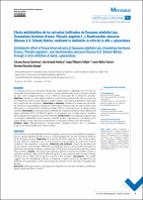Efecto antidiabético de los extractos liofilizados de Guazuma ulmifolia Lam., Dracontium loretense Krause, Physalis angulata L, y Handroanthus obscurus (Bureau & Schum) Mattos, mediante la inhibición in vitro de la α-glucosidasa
Related Resource(s)
https://rpmi.pe/index.php/rpmi/article/view/557Date
2020-03-07Author(s)
Ayarza Contreras, Tatiana
Aranda-Ventura, José
Villacrés Vallejo, Jorge
Núñez Tuesta, Lener
González-Aspajo, Germán
Metadata
Show full item recordAlternate title
Antidiabetic effect of freeze-dried extracts of Guazuma ulmifolia Lam., Dracontium loretense Krause, Physalis angulata L, and Handroanthus obscurus (Bureau & Schum) Mattos, through in vitro inhibition of α -glucosidase
Abstract
La etnomedicina es una disciplina idónea para elegir especies vegetales con el fin de ser estudiadas farmacológicamente; las cuatro especies seleccionadas para el presente estudio se usan como hipoglucemiantes en la medicina tradicional de la Amazonía peruana. Objetivos. Estudiar la capacidad inhibitoria in vitro de los extractos de cuatro plantas de uso tradicional, sobre la actividad de la α-glucosidasa, una enzima importante involucrada en la regulación de la glicemia. Materiales y métodos. Mediante el ensayo de inhibición de la enzima α-glucosidasa se evaluaron diferentes concentraciones de cada extracto para determinar la concentración inhibitoria media (IC50) y compararlos con la droga control acarbosa. Resultados. El extracto acuoso liofilizado de Guazuma ulmifolia mostró significante efecto inhibitorio (IC50 :13,49±3,65 μg/mL), al compararlo con la droga control, acarbosa (IC50: 858,67±29,73 μg/mL) y los otros extractos. Conclusiones. Los resultados sugieren que la actividad antidiabética de la Guazuma ulmifolia estaría mediada por la inhibición de la α-glucosidasa, lo que implicaría su potencial en la reducción de la glucosa posprandial. Ethnomedicine is an ideal discipline for choosing plant species to be studied pharmacologically;
the four species selected for this study are used as hypoglycemics in the traditional medicine
of the Peruvian Amazon. Objectives. To study the inhibitory capacity in vitro of the extracts
of four plants of traditional use, on the activity of α-glucosidase, an important enzyme
involved in the regulation of glycemia. Materials and methods. Using the inhibition test
of the enzyme α-glucosidase, different concentrations of each extract were evaluated to
determine the average inhibitory concentration (IC50) and to compare them with the control
drug acarbose. Results. The freeze-dried aqueous extract of Guazuma ulmifolia showed a
significant inhibitory effect (IC50:13,49±3,65 μg/mL) when compared with the control drug,
acarbose (IC50: 858,67±29,73 μg/mL), and the other extracts. Conclusions. The results
suggest that the antidiabetic activity of Guazuma ulmifolia would be mediated by the
inhibition of α-glucosidase, which would imply its potential in the reduction of postprandial
glucose.






